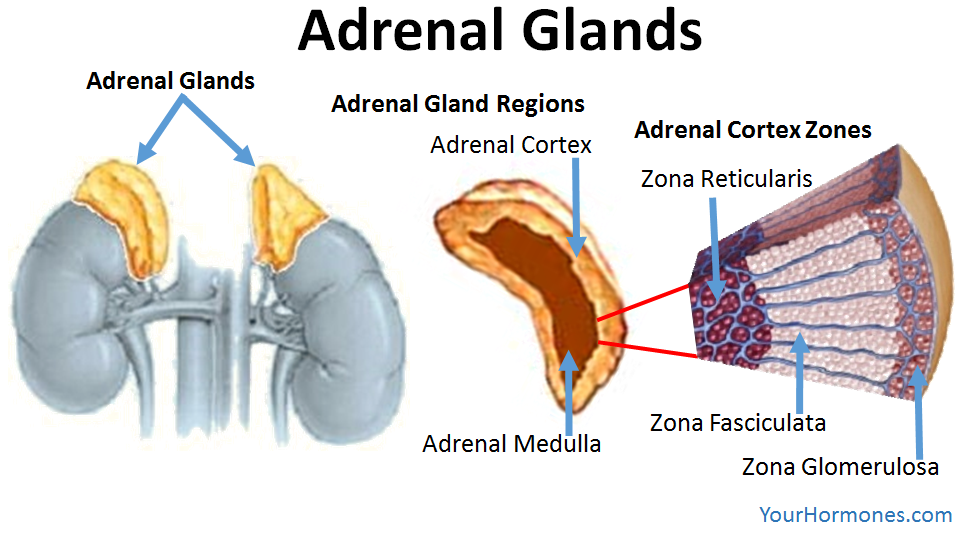
Structure and Hormones of the Adrenal Glands
The previous article about adrenal stress and adaptation discussed the concepts of stress, homeostasis and allostasis. We can now learn how stress affects the various regions and zones of the adrenal glands. There are two adrenal glands, one at the top of each kidney. The adrenal glands produce a specific amount of very important hormones on a daily basis to promote general health, and maintain the processes involved in homeostasis. The amount of those hormones changes due to a response to stress. Each adrenal gland has two different regions, the adrenal cortex and the adrenal medulla.
The adrenal medulla is the innermost core of the adrenal gland, which produces and releases the hormones epinephrine and norepinephrine. These two hormones are also known as adrenalin and noradrenaline respectively, and are also referred to as catecholamines or as neurotransmitters, because small amounts are also produced by the nervous system. The amount of epinephrine and norepinephrine that are released may be increased by different forms of stress.
The adrenal cortex is the outermost layer, which makes steroid hormones such as progesterone, DHEA and cortisol. The amount of cortisol and DHEA may initially be increased by different forms of stress, but the levels my decrease if stress is prolonged or too intense.
The adrenal cortex has three different zones, which are identified as zona glomerulosa, zona fasciculate & zona reticularis. Even though there is a slight overlap in what each zone produces, it is generally recognized that each zone produces the majority of specific hormones for that region.
The zona glomerulosa produces hormones with mineralocorticoid activity such as aldosterone, a steroid hormone that affect electrolyte levels and can causes water and sodium retention, and loss of potassium. Pregnenolone and progesterone are also made in this region, which is significant because even progesterone has some mild mineralocorticoid activity.
The zona fasciculate produces glucocorticoids such as cortisol, which is famous for being the “stress hormone”, but also has a number of important functions.
The zone reticularis produces androgens such as DHEA, and androstenedione, which can both act as precursors for sex hormones.
When the body is healthy, and in homeostasis, it makes a steady and healthy amount of all of those hormones from the adrenal cortex, as well as healthy amounts of the hormones from the adrenal medulla. However, the levels of these hormones change when the adrenal gland responds to stress.
Adrenal Gland Response to Stress
Under stress, the adrenal cortex often makes less DHEA and androstenedione, and more cortisol, corticosterone and aldosterone. At the same time, the adrenal medulla will release more norepinephrine and epinephrine. This can result in an increase in blood sugar levels, increased heart rate, and increased heart muscle contractions, as well as an increase in the rate and depth of respiration. The body will also hold on to water and sodium and make less urine. The increased amount of fluid in the vascular system can help get through a crisis. This may be good in the short term because the muscles have more blood glucose, more blood pressure, and increased oxygenation. This is the fight or flight stress response, that allows a stressed person to either run from the stress or fight the stress. This is allostasis. The body is in a different state, and is prepared for fight or flight.
If this shift goes on for a long period of time it can lead to serious problems including elevated blood sugar, high blood pressure, decreased production of sex hormones and other problems. In addition to the adrenal glands, other regulatory systems can also be affected by intense or prolonged stress.
The Two Regulatory Systems of the Adrenal Glands
The adrenal cortex responds to stress by hormonal signals it receives from the hypothalamic and pituitary glands which work together to monitor the health of the body. When there is increased stress of any kind the hypothalamic and pituitary glands release more of a hormone called ACTH. The increased ACTH levels stimulate the adrenal cortex to produce and release more of the adrenal cortex hormones. This relationship between the adrenal glands and the hypothalamic and pituitary glands is called the hypothalamic-pituitary-adrenal axis. (HPA axis). The HPA axis is a very important regulatory system.
The adrenal medulla responds to stress by releasing increased amounts of norepinephrine and epinephrine (adrenaline). It receives its instruction to make extra norepinephrine and epinephrine from the sympathetic nervous system. This connection is called the sympatho-adrenal system (SAS), which is another important regulatory system.
The hypothalamic-pituitary-adrenal axis (HPA axis) and the sympatho-adrenal system (SAS) are the two regulatory systems of the adrenal glands that work together and make the adrenal gland the initial, primary, and most important of the many regulatory systems that help the body maintain homeostasis and health or guide the body through stress and allostasis if needed.
Introduction to Adrenal Fatigue
Even though the term “adrenal fatigue” may not communicate the reality that we are dealing with multiple systems becoming overburdened and fatigued, the term “adrenal fatigue” does have merit in that the regulatory systems involving the adrenal glands that are typically the first systems to respond to stress.
However, the phrase “adrenal fatigue” implies that the adrenal glands carry the full responsibility to respond to stress and to maintain vitality, energy and homeostasis, and that when we feel tired, it is because the “adrenal glands are fatigued”. In truth, there and are a number of other regulatory systems that also respond to stress and work together to maintain homeostasis. So, the first thing we need to know about “adrenal fatigue” is that fatigue disorders involve much more than just the adrenal glands.
Next: Learn about Adrenal Fatigue
Learn how to order AdrenoMend™
